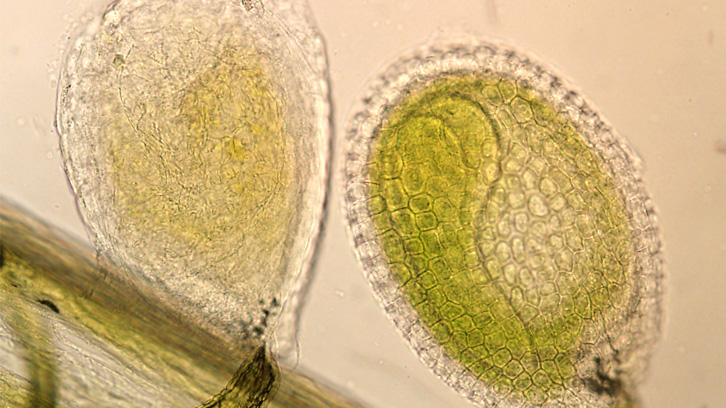Embryo development and photosynthesis in a single gene

Plant isoprenoids are indispensable compounds for respiration (ubiquinone) and photosynthesis (chlorophylls, carotenoids), being also important for the plant communication with its environment (pigments, volatiles, etc.). Most of them are derived from geranylgeranyl diphosphate (GGPP) synthesized from GGPPS (GGPP synthases). The quintessential model organism in plant biology, Arabidopsis thaliana, has five genes encoding for GGPPS enzymes. Earlier this year, a research group from the Centre for Research in Agricultural Genomics (CRAG), led by Dr. Manuel Rodríguez-Concepción, together with ETH Zurich University researchers, discovered that only one among these five genes is essential for the survival of the plant, the GGPPS11 or G11 gene.
“This is strange; when there are enzymes from the same family it is expected that if one fails another will recover its functions allowing the survival of the plant, but with G11 it doesn’t happen” explains M. Victoria Barja, pre-doctoral student and one of the authors of the paper published this January in New Phythologist journal(1). It was believedthat the G11 gene was essential because it was the only one producing GGPP for photosynthesis. Nevertheless, a recent paper published by the same research group in the Plant Physiology journal(2) proves that the same gene is also essential for embryo development.
 One gene but two enzymes and two functions
One gene but two enzymes and two functions
Analyzing different Arabidopsis plants with mutations in the G11 gene, the CRAG team noticed that some mutations caused embryo abortion while others allowed embryo development but generated albino plants (without chlorophyll). The researchers hypothesized that the G11 gene could produce two different proteins with different functions: a large protein, which would be responsible for GGPP production for chlorophylls and other compounds necessary for the photosynthesis in chloroplasts, and a second shorter protein, lacking the region required for transportation to the chloroplasts, which would be involved in the production of GGPP for embryo development.
To test the hypothesis, the researchers introduced into plants with lethal mutations a fragment of the G11 gene that could only produce the short protein, and observed that albino plants were produced. That is, the short protein produces GGPP essential for embryo development, but since it is not transported to the chloroplast, it cannot synthesize GGPP for the photosynthesis.
The next step for M. Victoria Barja and Manuel Rodríguez-Concepción’s team will be to analyze if this mechanism is replicated in species of agronomic interest, like tomato. Isoprenoids have indispensable functions in vegetal species but also for our health. A better understanding of the mechanisms regulating the production of an essential protein for plant development or a protein needed for photosynthesis from the same gene, will have a great impact in improving seed quality and plant growth.
(2) Communication and Outreach CRAG
References
(1) Ruiz-Sola MA, Coman D, Beck G, Barja MV, Colinas M, Graf A, Welsch R, Rütimann P, Bühlmann P, Bigler L, et al. (2016) Arabidopsis GERANYLGERANYL DIPHOSPHATE SYNTHASE 11 is a hub isozyme required for the production of most photosynthesis-related isoprenoids. New Phytol 209: 252–264. doi: 10.1111/nph.13580
(2) M. Águila Ruiz-Sola, M. Victoria Barja, David Manzano, Briardo Llorente, Bert Schipper, Jules Beekwilder, and Manuel Rodriguez-Concepcion (2016) A Single Arabidopsis Gene Encodes Two Differentially Targeted Geranylgeranyl Diphosphate Synthase Isoforms. Plant Physiol. 2016 Nov; 172(3): 1393–1402.doi: 10.1104/pp.16.01392

